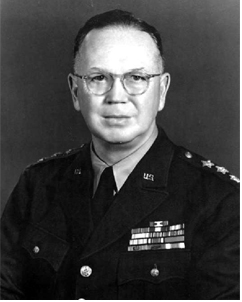Lieutenant General
Henry S. Aurand Sr.
 Born on April 21,
1894, Henry S. Aurand, Sr. graduated from West Point in 1915 and was commissioned in the Coast Artillery Corps. In
1917, while serving as a proof officer at Sandy Hook, NJ, the Army's only proving ground, he helped design and
supervise construction of the new proving ground at Aberdeen. In 1920, he transferred to the Ordnance Department.
Born on April 21,
1894, Henry S. Aurand, Sr. graduated from West Point in 1915 and was commissioned in the Coast Artillery Corps. In
1917, while serving as a proof officer at Sandy Hook, NJ, the Army's only proving ground, he helped design and
supervise construction of the new proving ground at Aberdeen. In 1920, he transferred to the Ordnance Department.
During the interwar years, Aurand served in a series of student, instructor, and field assignments that broadened and deepened his expertise as an Ordnance officer and logistician. He graduated from the Army Command and Staff College, the Army War College, and the Army Industrial College. He taught at the Ordnance School at Watertown Arsenal and the Army War College. And, he served as an Ordnance officer in the Philippines, in the V Corps Area, at Raritan Arsenal, and at Picatinny Arsenal. In 1932, he applied the expertise he had acquired from these assignments to the development of a seminal doctrinal manual, the Ordnance Field Manual. Later versions of this manual were the mainstay of Ordnance field operations in World War II.
As an Ordnance officer in the V Corps Area, Aurand became involved in mobilization planning. As a result of his contributions in developing an Industrial Mobilization Plan, he was selected in 1924 for a special assignment in the Office of the Chief of Ordnance to work on the Army Industrial Mobilization Plan. Later, just prior to World War II, his recognized skill as a planner led to his assignment as Chief, Plans and requirements, Army G-4, where he assisted in the preparation of the Army's Victory Plan and was instrumental in starting the Lend-Lease Aid Program.
During World War II, Aurand served in a series of key general officer positions. He commanded the Sixth Service Command, headquartered in Chicago, from 1942 until 1944. He then took command of the Normandy Base section in France, which pushed supplies forward during the critical period of the Battle of the Bulge. During this assignment, he pioneered the use of IBM punch cards to manage the base section ammunition inventory. Subsequently, he served as Commanding General, Service of Supply, China Theater; and, at the war's end, as the last Commanding General of the Africa-Middle East Theater.
In 1946, Aurand faced a typical post-war demotion from major general to brigadier general, and considered retirement until General Dwight D. Eisenhower, the new Army Chief of Staff, summoned him to serve as War Department Director of Research and Development. A third star came in 1948 when he was appointed as the first Director of Logistics for the Department of the Army.
LTG Aurand culminated his career as Commanding General, US Army Pacific; and retired in August 1952 after 37 years of service. He died in 1980.